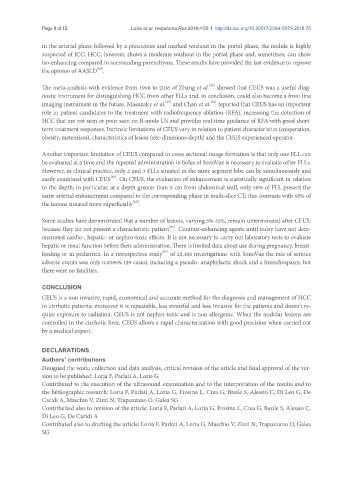Page 647 - Read Online
P. 647
Page 8 of 12 Loria et al. Hepatoma Res 2018;4:59 I http://dx.doi.org/10.20517/2394-5079.2018.75
in the arterial phase followed by a precocious and marked washout in the portal phase, the nodule is highly
suspected of ICC; HCC, however, shows a moderate washout in the portal phase and, sometimes, can show
iso-enhancing compared to surrounding parenchyma. These results have provided the last evidence to reprove
[80]
the opinion of AASLD .
[82]
The meta-analysis with evidence from 1998 to 2016 of Zhang et al. showed that CEUS was a useful diag-
nostic instrument for distinguishing HCC from other FLLs and, in conclusion, could also become a front line
[83]
[84]
imaging instrument in the future. Masuzaky et al. and Chan et al. reported that CEUS has an important
role in patient candidates to the treatment with radiofrequency ablation (RFA), increasing the detection of
HCC that are not seen or poor seen on B-mode US and provides real-time guidance of RFA with good short-
term treatment responses. Intrinsic limitations of CEUS vary in relation to patient characteristics (cooperation,
obesity, meteorism), characteristics of lesion (site-dimesions-depth) and the CEUS experienced operator.
Another important limitation of CEUS compared to cross sectional image formation is that only one FLL can
be evaluated at a time and the repeated administration in bolus of SonoVue is necessary to evaluate other FLLs.
However, in clinical practice, only 2 and 3 FLLs situated in the same segment lobe can be simultaneously and
[85]
easily examined with CEUS . On CEUS, the evaluation of enhancement is statistically significant in relation
to the depth; in particular, at a depth greater than 9 cm from abdominal wall, only 58% of FLL present the
same arterial enhancement compared to the corresponding phase in multi-slice CT; this contrasts with 95% of
[86]
the lesions situated more superficially .
Some studies have demonstrated that a number of lesions, varying 5%-25%, remain unterminated after CEUS,
[86]
because they do not present a characteristic pattern . Contrast-enhancing agents until today have not dem-
onstrated cardio-, hepatic- or nephro-toxic effects. It is not necessary to carry out laboratory tests to evaluate
hepatic or renal function before their administration. There is limited data about use during pregnancy, breast-
[87]
feeding or in pediatrics. In a retrospective study of 23,188 investigations with SonoVue the rate of serious
adverse events was only 0.0086% (29 cases), including a pseudo- anaphylactic shock and a bronchospasm, but
there were no fatalities.
CONCLUSION
CEUS is a non invasive, rapid, economical and accurate method for the diagnosis and management of HCC
in cirrhotic patients; moreover it is repeatable, less stressful and less invasive for the patients and doesn’t re-
quire exposure to radiation. CEUS is not nephro-toxic and is non allergenic. When the nodular lesions are
controlled in the cirrhotic liver, CEUS allows a rapid characterization with good precision when carried out
by a medical expert.
DECLARATIONS
Authors’ contributions
Designed the work, collection and data analysis, critical revision of the article and final approval of the ver-
sion to be published: Loria F, Parlati A, Loria G
Contributed to the execution of the ultrasound examination and to the interpretation of the results and to
the bibliographic research: Loria F, Parlati A, Loria G, Frosina L, Crea G, Basile S, Alessio C, Di Leo G, De
Caridi A, Maschio V, Zizzi N, Trapuzzano O, Galea SG
Contribuited also to revision of the article: Loria F, Parlati A, Loria G, Frosina L, Crea G, Basile S, Alessio C,
Di Leo G, De Caridi A
Contributed also to drafting the article: Loria F, Parlati A, Loria G, Maschio V, Zizzi N, Trapuzzano O, Galea
SG

